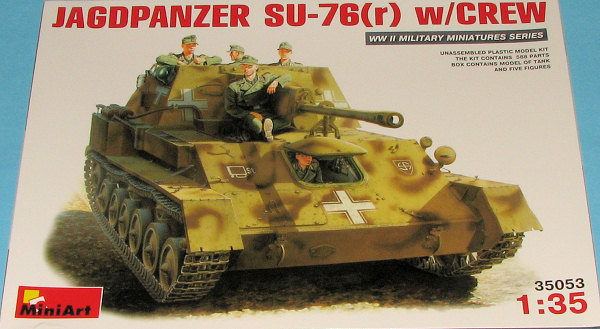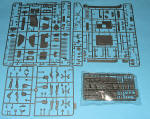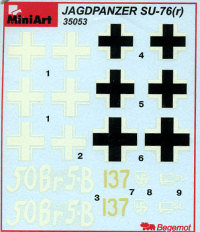
Miniart 1/35 Jagdpanzer SU-76(r) with crew
| KIT: | Miniart 1/35 Jagdpanzer SU-76(r) with crew |
| KIT #: | 35053 |
| PRICE: | $ |
| DECALS: | Three options |
| REVIEWER: | Scott Van Aken |
| NOTES: |

| HISTORY |
The SU-76 was based on a lengthened version of the T-70 tank chassis. Its simple construction made it the most-produced Soviet armoured vehicle of World War II, except for the T-34 tank.
Crews loved this vehicle for its simplicity, reliability, and ease of use, although it sometimes was nicknamed suka ('Bitch'), Suchka ('little bitch') or Golozhopiy Ferdinand ('naked-ass Ferdinand') for its relatively thin armour in the back. One famous crewman was Rem Nikolaevich Ulanov, who is a distinguished Great Patriotic War veteran. In his younger days he was a mechanic-driver and later a commander of an SU-76. He and some other soldiers called their SU-76 Columbina after female personage of Renaissance Italian Commedia dell'Arte.
The design work of SU-76 had begun in November 1942, when the State Defense Committee ordered the construction of infantry support self-propelled guns armed with the ZiS-3 76.2-mm gun and the M-30 122-mm howitzer. The base of a light tank T-70 was chosen for mounting the ZiS-3 gun, and it was lengthened, adding one road wheel per side, to facilitate better gun mounting.
In the rush for fast completion of the order a quite unreliable power plant was installed in the first mass production SU-76. It utilized two automobile engines (GAZ-202) in "parallel" junction. Practically, each track had its own engine and it was quite difficult for the driver to control two engines simultaneously. Moreover, the strong vibrations lead to quick mechanical failure of the engine or transmission units. The vehicle was completely closed by armour. After producing 320 SU-76s, mass production was halted by authorities in order to fix the problems. Two chief designers of GAZ plant, N. A. Astrov and A. A. Lipgart, quickly changed the power plant to the reliable T-70 design. Also the roof of battle compartment was removed for better gun servicing. This modification, called SU-76M, was relaunched in mass production in early 1943. This pause was the cause for introducing SU-76i as a temporary replacement for SU-76. After the pause, GAZ and two factories in Kirov and Mytishchi produced 13932 SU-76M (the larger part of the order, over 9000 vehicles, was built by GAZ solely). Mass production of SU-76M ceased in the second half of 1945. Now the SU-76Ms (due to their vast number in comparison with original design SU-76) are often referred in texts, public radio and TV broadcasting as simply SU-76s with index "M" omitted. The SU-76 was the base for first Soviet tracked armoured anti-aircraft vehicle ZSU-37. The mass production of ZSU-37 was continued after ceasing SU-76M production. The SU-76M was quickly withdrawn from Soviet Army service after the Second World War ended.
| THE KIT |
 MiniArt's kit is very nicely molded with two main sprues and a number of smaller ones for running gear and tracks. The kit comes with individual link tracks. These make up a goodly percentage of the 558 parts count. Generally, I found that there were a few sink areas on some of the larger pieces where there was thick detail on the other side of the piece; like the side shields. Since they are on flat areas, filling them should be a breeze. I also noticed that there were areas of mold release on some bits so it would be a good idea to wash the sprues in warm, soapy water to remove this.
MiniArt's kit is very nicely molded with two main sprues and a number of smaller ones for running gear and tracks. The kit comes with individual link tracks. These make up a goodly percentage of the 558 parts count. Generally, I found that there were a few sink areas on some of the larger pieces where there was thick detail on the other side of the piece; like the side shields. Since they are on flat areas, filling them should be a breeze. I also noticed that there were areas of mold release on some bits so it would be a good idea to wash the sprues in warm, soapy water to remove this.
The detail work on the gun itself is very good with a nicely done barrel and recoil/mounting mechanism. The hull is a single piece onto which the various upper hull panels and the suspension is attached. As this is an open vehicle, there are quite a few additional bits and pieces to add to the fighting compartment, and much of this consists of individual shells and their containers. When you add in additional rifles and round cases, you'll have a very busy area.
their containers. When you add in additional rifles and round cases, you'll have a very busy area.
Instructions are well drawn with some photos of burned out or captured vehicles to add some suggestions. It was common for the German army to use captured vehicles in battle, scrounging rounds from other vehicles or various other sources. This kit has a full color markings and painting guide with Vallejo, Testors, Tamiya, Humbrol, Revell and Mr.Color references. The first two vehicles are in general green shades from unknown units. The first from Poland in 1944 and the second, marked '50Br5-B' on the side from Konigsberg in 1945. The third, which is the box art tank, is from SS Panzer Division 'Wiking' in Poland during the Summer of 1944. Decals are printed by Begemot and look to be quite well done.
This kit also contains five figures from their SPG Riders set and full color assembly and painting guide is provided for these figures.
| CONCLUSIONS |
Overall an excellent kit that includes a crew so no need to fork out for another kit to add some life to it. It is a vehicle I've rarely seen kitted, much less built and should make a very nice addition to your collection.
| REFERENCES |
March 2008
My thanks to www.dragonmodelsusa.com for the review sample. Get yours at your local shop or ask them to order it for you. If you would like your product reviewed fairly and fairly quickly, please contact the editor or see other details in the Note to Contributors.